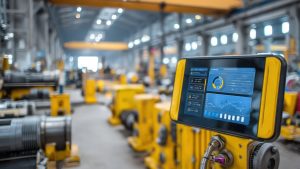Ever wondered how some companies avoid equipment breakdowns with what seems like magic? The secret often lies in predictive maintenance powered by machine learning. This method transforms how industries cope with system protection, turning sudden screw-ups into a difficulty of the beyond.
The role of machine learning in predictive maintenance isn’t always a mile-off dream. Many businesses already use it, knowing that a surprising machine failure can halt manufacturing and result in sizeable economic losses.
Table Of Contents:
- The Shift Towards Smarter Maintenance
- The Role of Machine Learning in Predictive Maintenance Benefits
- Real-World Examples Show Predictive Maintenance
- Getting Started with Predictive Maintenance and Machine Learning
- Future of Predictive Maintenance
- Conclusion
The Shift Towards Smarter Maintenance
Traditionally, maintenance has been either “reactive” (fixing things once they break) or “preventive” (doing maintenance on a schedule, whether it’s needed or not). Both approaches have their downsides.
Reactive maintenance leads to downtime and costly repairs. Preventive maintenance, while better, can result in unnecessary work and expense if performed too often. Only about 20% of equipment failures are due to age, meaning 80% happen unexpectedly.
Predictive maintenance uses data to forecast when a problem *will* occur. Addressing the issue in advance cuts cost and reduces downtime.
What Exactly is Predictive Maintenance?
Predictive maintenance uses data collection to anticipate equipment needs. It’s more than just attaching a sensor to a machine. It’s a deliberate and continuous process.
Data is gathered from different sources. Sensors measure things like vibration, temperature, and other important metrics.
This constant monitoring provides the information needed to forecast equipment operations and potential failures. Advanced analytics then help interpret these signals.
Why Machine Learning is Essential
This is where the real intelligence comes into play. Machine learning algorithms give predictive systems their power.
Machine learning models analyze the large amounts of sensor data. They identify patterns indicative of potential issues that humans might miss. These could include slight temperature increases or minor vibration changes that a trained machine learning algorithm could easily detect.
These machine learning algorithms adapt and refine their analysis as machines experience wear and tear. They learn the normal operating parameters of equipment, and anomaly detection helps signal to maintenance teams which require inspection. This constitutes a proactive approach.
The Role of Machine Learning in Predictive Maintenance Benefits
So, what are the practical benefits? A study by Deloitte highlighted several key advantages that business leaders are actively utilizing.
Here are a few:
- Reduced Downtime: Unplanned downtime is significantly reduced by addressing potential problems before they escalate. For some industries, an hour of machine downtime can cost over $260,000.
- Lower Maintenance Costs: Maintenance activities are performed only when necessary, rather than on a fixed maintenance schedule. This leads to lower costs for parts and labor over time. Deloitte highlights that maintenance costs can be reduced by up to 10%, and system uptimes may increase by up to 20% using proactive maintenance strategies like predictive maintenance.
- Improved Operational Efficiency: Knowing a machine will need attention in two weeks, rather than tomorrow, allows for better planning of downtime, shift changes, and logistics. Predicting these errors allows the entire plant to run more smoothly, as resources aren’t diverted to easily avoidable critical issues.
- Longer Equipment Lifespan: Addressing problems early prevents them from becoming major issues that could shorten the lifespan of components. Proactive fixes, instead of waiting for complete failures, increase the overall expected longevity of equipment, allowing for more practical long-term planning.
Predictive maintenance can also reduce carbon emissions. One discovered benefit companies value is its contribution to sustainability. A PwC study revealed that improving how equipment functions can increase efficiency by making systems function longer with less change in system conditions as machines are used longer.
The Main Types of Machine Learning at Work
Different machine learning algorithms are suited for different types of predictions.
- Regression Models: These predict a *value*, such as the estimated remaining life of a component.
- Classification Models: These are good at determining the *type* of problem that is likely developing. The system distinguishes between a bearing issue, an electrical fault, or another issue.
- Anomaly Detection: Sometimes, the key isn’t to predict a specific failure, but to spot anything unusual, triggering a closer inspection by a maintenance team.
- Deep Learning: Complex neural networks analyze extensive data. A Neural Concept article explains deep learning is adept at uncovering intricate, multi-level correlations that simpler analysis methods cannot achieve alone.
How to Use Algorithms In Predictive Maintenance
Predictive maintenance relies on algorithms to detect potential equipment issues. Many algorithms are used to analyze data and signals.
Here are some common algorithms used:
- Regression Analysis: Identifies how connections within a feature set influence behaviors to optimize predictions.
- Time Series Analysis: Employs regression techniques to find patterns in chronological sensor data.
Real-World Examples Show Predictive Maintenance
This technology isn’t just theoretical. Many organizations have used it for years, seeing substantial benefits. Large organizations, where operational interruptions can have severe financial consequences, are prime examples.
Predictive systems offer valuable insights. Maintenance planning becomes more precise, based on likely failures rather than just average calculations.
Manufacturing
In manufacturing, downtime costs can be enormous, potentially reaching $50 billion annually. One company utilizing predictive maintenance is Aramco. They use these systems to monitor wells for early signs of damage.
Over 40% of facilities have processes in place to use data analytics to minimize risks to productivity and improve the ROI of systems and assets.
Healthcare
Hitachi uses analytics to reduce downtime on their MRI machines.
Automotive
Car companies also use predictive systems. Opel offers optimized checkup recommendations to customers based on tracked data.
Bell Flight is integrating AI-based solutions into its aircraft designs.
Putting it All Together – A Simplified Example
Consider a large pump in a water treatment plant. Instead of relying on scheduled, general maintenance, a predictive model would continuously monitor:
- Vibration: Minute changes could indicate bearing wear.
- Temperature: An increase in temperature might indicate lubrication problems.
- Flow Rate: A decrease could point to a blockage.
If an algorithm detected an anomaly, it would trigger an alert for a closer inspection to address the potential cause. This prevents costly overhauls. A small repair with minimal downtime is far preferable to an unexpected major breakdown, potentially costing hundreds of thousands of dollars.
Getting Started with Predictive Maintenance and Machine Learning
Adoption doesn’t have to be a complete overhaul all at once. You can focus on key systems before fully integrating a plant-wide approach.
Here’s a basic outline:
- Identify Critical Assets: Prioritize machines that are prone to issues, crucial for operations, or have high downtime costs.
- Collect Data: Many facilities may already gather data. Often data sets require augmenting to incorporate information related to machine failures, such as those shared in this article.
- Choose the Right Tools: Software solutions that leverage machine learning must analyze the data. Initially, it may be more effective to collaborate with experienced service providers rather than building an internal system, especially for specialized situations.
- Start Small: Begin with pilot tests before full-scale deployment. Running models is also beneficial; each change and variable, along with its impact on the algorithm’s prediction ability, should be documented.
Working with the Data: It All Starts There
The importance of data in machine learning predictive maintenance cannot be overstated. Sensors provide crucial visibility. The table below outlines typical data types used. Data acquisition should be as detailed as possible to gain deeper insights when tracking equipment condition trends.
The critical factors for data collect include completeness, accuracy, and consistency when tracking details to derive significant value from the overall effort.
| Data Type | What It Reveals |
|---|---|
| Vibration Analysis | Identify patterns of early wear in rotating parts. |
| Temperature | Overheating issues and parts in friction. |
| Oil Analysis | The health of lubricated components. |
| Acoustic Analysis | Identifies leaks or subtle changes in a machine’s operational sound. |
| Current | Electrical conditions as power to different circuits operate. |
Future of Predictive Maintenance
The growth forecast for systems enhancing predictive capabilities is substantial. Anticipated yearly value gains are over 29% annually for much of the rest of the decade. More industries will likely adopt AI-driven analytics for equipment monitoring.
Edge computing brings AI closer, enabling more efficient data analysis. Reinforcement learning will become more relevant to aid this. This combination of processes is what will continue to support strong growth for AI and its impact on predictive maintenance solutions.
McKinsey notes that partnering with the right experts is critical for successfully implementing machine learning tools and predictive techniques. Without adequate expertise, the impact of predictive maintenance is diminished.
Conclusion
Machine learning’s predictive capabilities offer new ways to improve operations across various sectors and businesses. The role of machine learning in predictive maintenance extends beyond just fixing machines. It provides a way to acquire critical insights that implement driven predictive maintenance, allowing companies to make informed decisions about resource allocation and improving their ability to plan for what previously seemed unpredictable.
A proactive company equipped with the right tools can eliminate the guesswork from its operations. By leveraging real-time and historical data, it has the power to predict and respond quickly, ensuring that maintenance activities are precisely aligned with operational needs. This approach helps businesses optimize maintenance, reducing unnecessary interventions while preventing costly breakdowns. As a result, organizations can achieve significant cost savings by minimizing downtime and extending the life of their equipment.
The integration of predictive maintenance powered by machine learning not only transforms maintenance practices but also drives overall operational efficiency, allowing businesses to stay ahead of potential issues and plan more effectively for the future.



